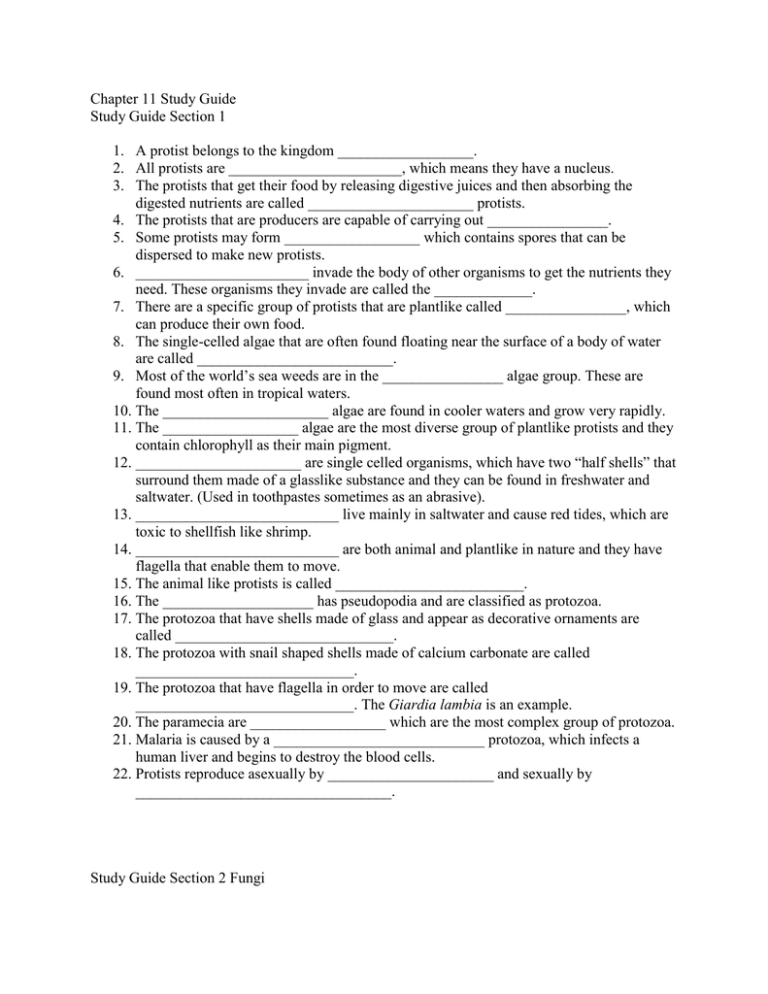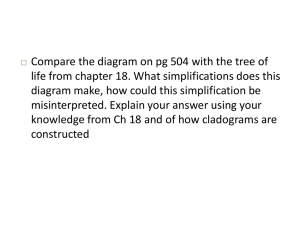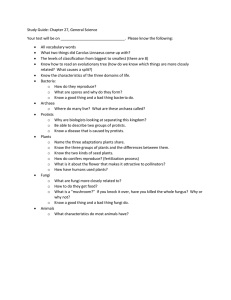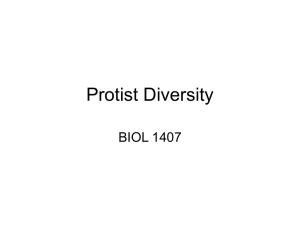Chapter 11 Study Guide Study Guide Section 1 A protist belongs to
advertisement

Chapter 11 Study Guide Study Guide Section 1 1. A protist belongs to the kingdom __________________. 2. All protists are _______________________, which means they have a nucleus. 3. The protists that get their food by releasing digestive juices and then absorbing the digested nutrients are called ______________________ protists. 4. The protists that are producers are capable of carrying out ________________. 5. Some protists may form __________________ which contains spores that can be dispersed to make new protists. 6. _______________________ invade the body of other organisms to get the nutrients they need. These organisms they invade are called the _____________. 7. There are a specific group of protists that are plantlike called ________________, which can produce their own food. 8. The single-celled algae that are often found floating near the surface of a body of water are called __________________________. 9. Most of the world’s sea weeds are in the ________________ algae group. These are found most often in tropical waters. 10. The ______________________ algae are found in cooler waters and grow very rapidly. 11. The __________________ algae are the most diverse group of plantlike protists and they contain chlorophyll as their main pigment. 12. ______________________ are single celled organisms, which have two “half shells” that surround them made of a glasslike substance and they can be found in freshwater and saltwater. (Used in toothpastes sometimes as an abrasive). 13. ___________________________ live mainly in saltwater and cause red tides, which are toxic to shellfish like shrimp. 14. ___________________________ are both animal and plantlike in nature and they have flagella that enable them to move. 15. The animal like protists is called _________________________. 16. The ____________________ has pseudopodia and are classified as protozoa. 17. The protozoa that have shells made of glass and appear as decorative ornaments are called _____________________________. 18. The protozoa with snail shaped shells made of calcium carbonate are called _____________________________. 19. The protozoa that have flagella in order to move are called _____________________________. The Giardia lambia is an example. 20. The paramecia are __________________ which are the most complex group of protozoa. 21. Malaria is caused by a ____________________________ protozoa, which infects a human liver and begins to destroy the blood cells. 22. Protists reproduce asexually by ______________________ and sexually by __________________________________. Study Guide Section 2 Fungi 1. A mushroom is an example of a _____________________ or _________________ if written plural. 2. Fungi are _______________, but they cannot eat or engulf food. 3. Fungi feed on ________________ plant and animals matter. 4. The chains of cells that make up fungi are called ________________. 5. The hyphae of a fungus grow into a twisted mass to form the _______________________. 6. The hyphae and mycelium are “out of sight” because they grow ____________________________. 7. ______________________ are small reproductive cells protected by a thick cell wall. 8. _____________________ are shapeless fuzzy fungi. (Hint: you may see some on bread). They are grouped into _____________________ fungi. 9. Threadlike fungi can reproduce asexually by producing __________________. These structures contain thousands of spores. 10. ________________ fungi are the largest group of fungi, which includes yeasts, mildews, and morels as examples. 11. Sexual reproduction in sac fungi involves the formation of sacs called a ______________. 12. Yeasts reproduce asexually by __________________. 13. Yeasts are used to make ______________ rise. The yeast feed on the sugars and gives off _______________________ gas that causes it to rise. 14. The classic mushroom is in the __________________ fungi. 15. During sexual reproduction, the hyphae of club fungi produce club-like structures called ____________________, which is the portion we refer to as a mushroom. 16. Beneath the “umbrella” portion of a mushroom we will find _______________ in which spores are stored before being released. 17. What are some other club fungi examples? 18. Athlete’s foot falls into the ________________ fungi group. 19. An important fungi that we get penicillin from is called _____________________. 20. What are some other uses of imperfect fungi? 21. A _____________________ is a combination of a fungus and an alga (algae – plural) that grows intertwined in a symbiotic relationship. 22. Which organism in the lichen is responsible for carrying out photosynthesis? 23. If lichens are not present and they should be in an ecosystem, what could be one possibility of why the lichens are absent?







